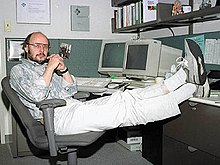History
In 1979, Bjarne Stroustrup, a Danish computer scientist, began work on the predecessor to C++, "C with Classes".[8] The motivation for creating a new language originated from Stroustrup's experience in programming for his Ph.D. thesis. Stroustrup found that Simula had features that were very helpful for large software development, but the language was too slow for practical use, while BCPL was fast but too low-level to be suitable for large software development. When Stroustrup started working in AT&T Bell Labs, he had the problem of analyzing the UNIX kernel with respect to distributed computing. Remembering his Ph.D. experience, Stroustrup set out to enhance the Clanguage with Simula-like features.[9] C was chosen because it was general-purpose, fast, portable and widely used. As well as C and Simula's influences, other languages also influenced C++, including ALGOL 68, Ada, CLU and ML.
Initially, Stroustrup's "C with Classes" added features to the C compiler, Cpre, including classes, derived classes, strong typing, inlining and default arguments.[10]
In 1983, C with Classes was renamed to C++ ("++" being the increment operatorin C), adding new features that included virtual functions, function name andoperator overloading, references, constants, type-safe free-store memory allocation (new/delete), improved type checking, and BCPL style single-line comments with two forward slashes (
//). Furthermore, it included the development of a standalone compiler for C++, Cfront.
In 1985, the first edition of The C++ Programming Language was released, which became the definitive reference for the language, as there was not yet an official standard.[11] The first commercial implementation of C++ was released in October of the same year.[8]
In 1989, C++ 2.0 was released, followed by the updated second edition of The C++ Programming Language in 1991.[12] New features in 2.0 included multiple inheritance, abstract classes, static member functions, const member functions, and protected members. In 1990, The Annotated C++ Reference Manual was published. This work became the basis for the future standard. Later feature additions included templates, exceptions, namespaces, newcasts, and a boolean type.
After the 2.0 update, C++ evolved relatively slowly until, in 2011, the C++11standard was released, adding numerous new features, enlarging the standard library further, and providing more facilities to C++ programmers. After a minorC++14 update, released in December 2014, various new additions are planned for 2017.
Etymology
According to Stroustrup: "the name signifies the evolutionary nature of the changes from C".[13] This name is credited to Rick Mascitti (mid-1983)[10] and was first used in December 1983. When Mascitti was questioned informally in 1992 about the naming, he indicated that it was given in a tongue-in-cheekspirit. The name comes from C's "++" operator (which increments the value of avariable) and a common naming convention of using "+" to indicate an enhanced computer program.
During C++'s development period, the language had been referred to as "new C" and "C with Classes"[10][14] before acquiring its final name.
Philosophy
Throughout C++'s life, its development and evolution has been informally governed by a set of rules that its evolution should follow:[9]
- It must be driven by actual problems and its features should be useful immediately in real world programs.
- Every feature should be implementable (with a reasonably obvious way to do so).
- Programmers should be free to pick their own programming style, and that style should be fully supported by C++.
- Allowing a useful feature is more important than preventing every possible misuse of C++.
- It should provide facilities for organising programs into well-defined separate parts, and provide facilities for combining separately developed parts.
- No implicit violations of the type system (but allow explicit violations; that is, those explicitly requested by the programmer).
- User-created types need to have the same support and performance as built-in types.
- Unused features should not negatively impact created executables (e.g. in lower performance).
- There should be no language beneath C++ (except assembly language).
- C++ should work alongside other existing programming languages, rather than fostering its own separate and incompatible programming environment.
- If the programmer's intent is unknown, allow the programmer to specify it by providing manual control.
Standardization
C++ is standardized by an ISO working group known as JTC1/SC22/WG21. So far, it has published four revisions of the C++ standard and is currently working on the next revision, C++17.
In 1998, the ISO working group standardized C++ for the first time as ISO/IEC 14882:1998, which is informally known as C++98. In 2003, it published a new version of the C++ standard called ISO/IEC 14882:2003, which fixed problems identified in C++98.
The next major revision of the standard was informally referred to as "C++0x", but it was not released until 2011.[18] C++11 (14882:2011) included many additions to both the core language and the standard library.[7]
In 2014, C++14 (also known as C++1y) was released as a small extension toC++11, featuring mainly bug fixes and small improvements.[19] The Draft International Standard ballot procedures completed in mid-August 2014.[20]
After C++14, a major revision, informally known as C++17 or C++1z, is planned for 2017,[19] which is almost feature-complete.[21]
As part of the standardization process, ISO also publishes technical reports and specifications:
- ISO/IEC TR 18015:2006[22] on the use of C++ in embedded systems and on performance implications of C++ language and library features,
- ISO/IEC TR 19768:2007[23] (also known as the C++ Technical Report 1) on library extensions mostly integrated into C++11,
- ISO/IEC TR 29124:2010[24] on special mathematical functions,
- ISO/IEC TR 24733:2011[25] on decimal floating point arithmetic,
- ISO/IEC TS 18822:2015[26] on the standard filesystem library,
- ISO/IEC TS 19570:2015[27] on parallel versions of the standard library algorithms,
- ISO/IEC TS 19841:2015[28] on software transactional memory,
- ISO/IEC TS 19568:2015[29] on a new set of library extensions, some of which are already integrated into C++17,
- ISO/IEC TS 19217:2015[30] on the C++ Concepts
More technical specifications are in development and pending approval, including concurrency library extensions, a networking standard library, ranges, and modules.[31]
source wikipedia
source wikipedia

Comments
Post a Comment